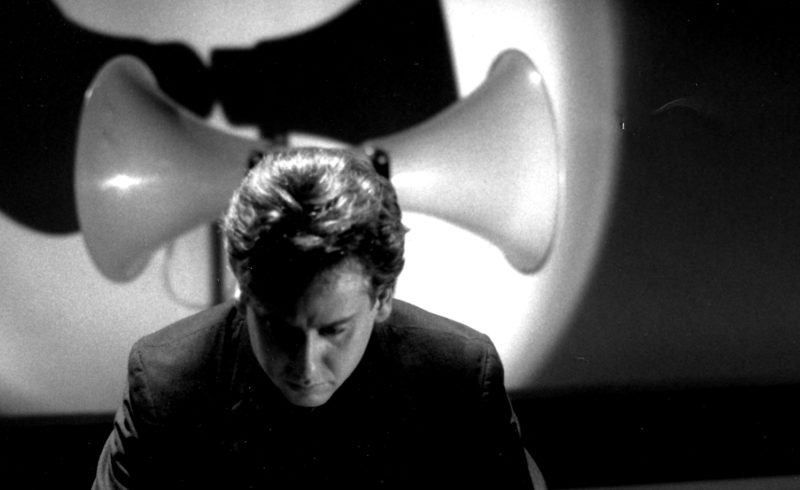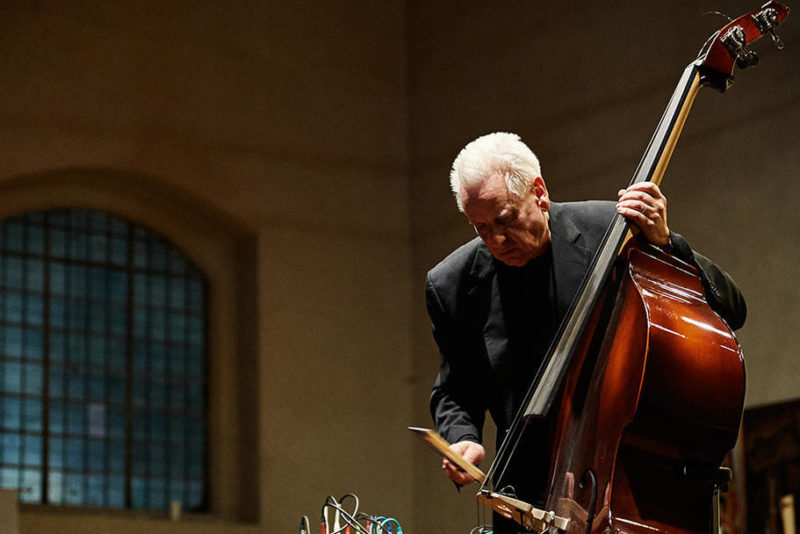Arnold Dreyblatt

Cristina Amelia
I am going to start this interview bluntly: What is a string for Arnold Dreyblatt?
Arnold Dreyblatt
It is a big question. Actually after leaving La Monte Young it has been a period of going out on my own and because I did not have a traditional music training I had to understand this whole world of tuning and acoustics, experiment with different types of instruments even with wind instruments. Back then I was reading Hermann von Helmholtz. When I came to the string, to experiment with the vibrating string, I used an experimental instrument which enabled an empirical relation to vibration. Only then did I understand that the vibrating string, in particular the monochord, was a sort of an instrument for teaching and understanding tuning and acoustics in many ancient cultures. Therefore I did a lot of research about that and began to make music which is based on a vibrating string. As it is written in books about acoustics “To excite a string means to set it into vibration.” Back in the days when I was studying with the Vasulkas there was much interest in wave forms and light forms. I came into music without any musical background so I needed to understand what is happening, all these numbers and tuning and complicated mathematics, or what it seemed to be complicated mathematics. With a string is simple because it can be divided and there you see one third it goes three times frequency and you can actually see it. It is a moving energy in time.
CA
Could you talk about your music pieces in relation to these three “concepts” : One (string), Multiplicity (orchestra of many string instruments) and Unit(y) (the first two together)?
AD
It is the principle of the waves we add to each other. A time wave is the simplest type of wave moving up and down and then we add what we call a complex wave form which means many waves in different frequencies that are related to each other through a mathematical relation.
With the instruments, I would say that first I added those who all play or perform on strings, maybe tubes or air columns, in vibrations that are related to each other. All this creates a big sound. I am interested in creating a big sound out of these related vibrations fusing together. Occasionally my solo base playing is reduced to one big string. There is a quote I often use from a French polymath which poses the question “Why does a string makes so many sounds at once?” What is in one sound? Therefore it is important that one string is sounded somewhere in the beginning of the concert because then you know how to listen to the sound that is being made altogether. When I perform solo I do two different pieces: the one is when the string vibrates and the other is magnetic resonance which is quite a departure for me.
CA
You seem to be a math oriented mind but the result comes from a gut process. Where and how are the limits between these two set?
AD
When I explain my music I say that first there is an intellect or what I call an intellectual or conceptual aspect where I combine these overtones, pitches, frequencies from different instruments that are related mathematically by their wave forms. That is one aspect but then there is banging on the string which produces these sounds and it is almost a reduced and simple activity. These two things happen at the same time. I think my music is very rhythmical but the rhythm is based on exciting, striking the strings and within that bringing other resonances in. It also has a very physical aspect and this comes from how I began dealing with the string and getting it to sound. There is a body, I am playing on a base which has a body; there is an expression in English ”the resonating body”.

CA
Can we also talk about a “system” behind it?
AD
Yes, there is one which I did not invent. There were others before me like Young or Conrad although I use exciting strings and tunings which they did not use. But in essence it is a basic system found in nature and what you have to do is make a scale out of that. There is nothing patented or anything. I have tried to write more complex rhythmic patterns with musicians. For instance the ensemble I have now (which will not play in Gent) is quite simple in terms of rhythm and it goes back to my early music. In fact, my first record is just been re-released as an LP by Drag City so that might be a good reference.
CA
What is your relationship as a musician with restrictions and restrains? Are you generating them in order to pose questions, allow total freedom or you set them for negotiations?
AD
In terms of reduction there is a sort of restriction. I am interested in certain resonances that are happening. An example would be when I use percussion. I like instruments that are metallic or drums, tuned very high with very little resonance so that it does not interfere with the strings and to give just the beat. There are restrictions in terms of how one plays. With bowed instruments I forbid vibrato. In case of rhythm compositions – which I can do only on the computer – I ask the musicians for no dynamics and it is very difficult for classic musicians to understand this. They think if it is slower it is going to be quieter.
CA
I have noticed that you have a special relationship with your instruments or to put it a bit pretentious a kind of object-oriented ontology to the detriment of anthropocentrism. Could you tell me whether there is a refusal to control the instrument and let it speak for itself or something else?
AD
Let us take the instrument which I am going to use for the show in Gent. It is a not a base but a double base, a contrabass body, a vibrating box with strings on of different length, in the violin range. I am using it to do a specific thing. It is very narrow compared to how one usually uses an instrument. If you take the word instrument, in its larger sense like scientific instrument, it is a very specialized object. So my base has strings that do only one thing, or one and a half and nobody else can play it. But when it comes to instruments I did not change, there I am interested in one particular way of playing, the tonal range and also the way of getting the sound. And of course there is the philosophical aspect. You can say that this is expression but it is hard to say what is expression. So it is not my expression, or it is somehow but it is not making the music. I want to make things to sound. A good example is a brass instrument. All brass players learn to change the intonation on their instruments to fit equal temperament. When I have to work with somebody new who plays the trumpet or something else there is a moment when I say ”Do not correct it. Just let it talk.”
CA
What is your position towards virtuosity?
AD
Virtuosity means to bend the instrument to someone's will. A violin player can make a violin sound like anything he wants. It is almost like colonialism.(laughs) I am not interested in that. I am interested in what it does as an instrument, in a banal sense.
CA
Now, everybody who has listened to your music knows that your teachers influenced generations of musicians and visual artists. I am obviously talking here about La Monte Young, Pauline Oliveros and the founders of The Kitchen the Vasulkas. What is your opinion about the importance of having a master, mentor, professor or role-model? What was your experience with them?
AD
It is very hard to quantify how much I have learned from them because with some I have spent one day, with others I just talked, with some I have spent two years in schools and with others it was just a moment. I also take as teachers people I have never met simply because I have read something by them on the right time or being exposed to their music at the right time. This can also have a major impact. My first music teacher was Pauline Oliveros during a workshop. I had no academic training (performing, singing, tones), although I used to do electronic music, and we spent an entire day which she did that with all participants individually. The sad thing now is the feeling that the only way one can meet musicians, be around them or talk to them is through school.
CA
Looking at some footages with you and The Orchestra of Excited Strings I couldn't help but notice the exquisite chemistry between you. Tell me more about this project and the inner workings of this group.
AD
This is different than when I have done recordings or when I had projects with let's say foreign musicians as in not working with them for a long period of time. Somehow in my own ensembles a sort of resonance is felt. In the early years we would give signals to each other in order for me to avoid counting bars. This works until now with my new group since 2009 which involves younger musicians.
CA
How do you pick them up? How do you find these new members?
AD
In the early days it was different and it was a generation change in the '90s realizing that there are many people interested in this sort of music. In the late '90s a young guy in his 20s, Jörg Hiller, approached me and I saw a bit of me in him. We did some playing together, he brought some other friends from that generation. What I liked was performing in this very young scene. More interest has been shown from this side than from the academic milieu. They gave a new life to my music and I really enjoy that. There is also a certain type of musician who would like to play with me. Lately things have change so much. You have these kids who are not musically trained but start working with sound. In the '90s it happened that song forms or lyrics were not necessary anymore. People could listen to sound and nothing more. It is a huge change.
CA
And to conclude on a circular note: What is East for Arnold Dreyblatt?
AD
Probably East-Coast (laughs). I did these projects in Eastern Europe in the 80's, my family comes from Eastern Europe and maybe that has something to do with it. I was thinking recently of Bela Bartok who was looking for the origins of his music in Hungary. He was not nationalistic and understood at some point that Hungarian, Romanian or Serbian folk music were related, dialects of each other. Then there was the question “Where does it come from?” and he traveled to Turkey in Anatolia. So, I guess it comes from the East.